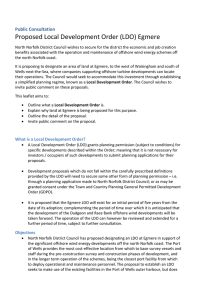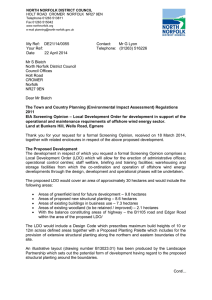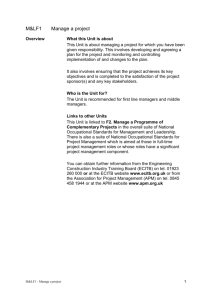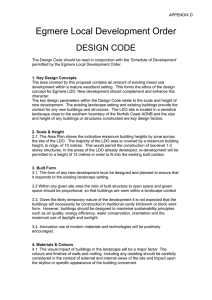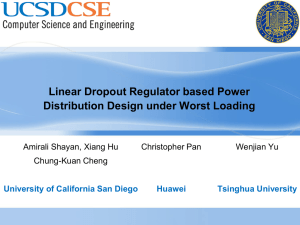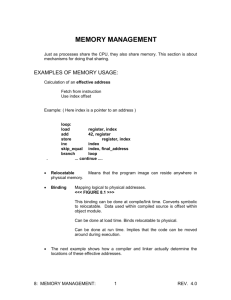Cabinet 13 May 2013 Full Council
advertisement
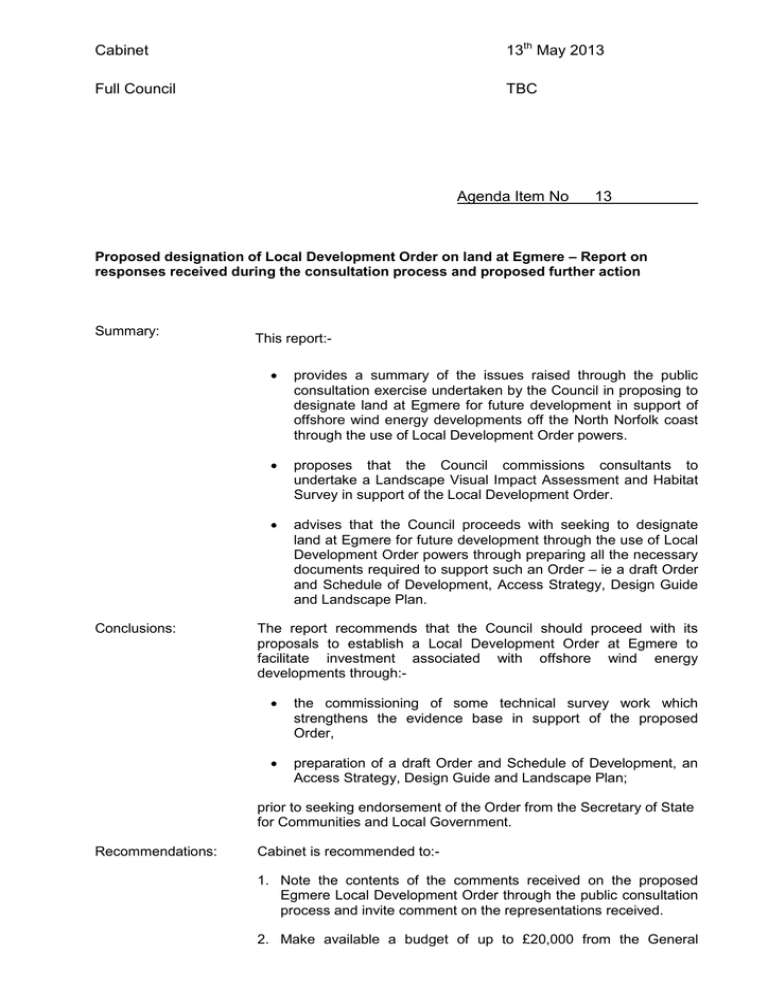
Cabinet 13th May 2013 Full Council TBC Agenda Item No___13__________ Proposed designation of Local Development Order on land at Egmere – Report on responses received during the consultation process and proposed further action Summary: Conclusions: This report: provides a summary of the issues raised through the public consultation exercise undertaken by the Council in proposing to designate land at Egmere for future development in support of offshore wind energy developments off the North Norfolk coast through the use of Local Development Order powers. proposes that the Council commissions consultants to undertake a Landscape Visual Impact Assessment and Habitat Survey in support of the Local Development Order. advises that the Council proceeds with seeking to designate land at Egmere for future development through the use of Local Development Order powers through preparing all the necessary documents required to support such an Order – ie a draft Order and Schedule of Development, Access Strategy, Design Guide and Landscape Plan. The report recommends that the Council should proceed with its proposals to establish a Local Development Order at Egmere to facilitate investment associated with offshore wind energy developments through: the commissioning of some technical survey work which strengthens the evidence base in support of the proposed Order, preparation of a draft Order and Schedule of Development, an Access Strategy, Design Guide and Landscape Plan; prior to seeking endorsement of the Order from the Secretary of State for Communities and Local Government. Recommendations: Cabinet is recommended to:1. Note the contents of the comments received on the proposed Egmere Local Development Order through the public consultation process and invite comment on the representations received. 2. Make available a budget of up to £20,000 from the General Cabinet 13th May 2013 Full Council TBC Reserve to commission a Landscape Visual Impact Assessment and Stage 1 Habitat Survey so as to strengthen the evidence base in support of the proposed Order, 3. Agree proposed changes to the area covered by the LDO designation as outlined at Section 8 of the report. 4. Provides delegated authority to the Corporate Director, in consultation with the Cabinet Portfolio holder for Planning, to proceed with preparing final documents in support of the Order before seeking approval of Full Council for the Local Development Order to be sent to the Secretary of State for Communities and Local Government for endorsement. Cabinet member(s): Ward(s) affected: Primarily Walsingham, with some impact on the Priory ward Cllr Tom FitzPatrick Cllr R Oliver Contact Officer, telephone number, and e-mail: Steve Blatch, Corporate Director Steve.blatch@north-norfolk.gov.uk Tel:- 01263 516232 Cabinet 13th May 2013 Full Council TBC 1.0 Introduction 1.1 At the meeting of Cabinet held on 13th December 2012, Cabinet received and endorsed a report proposing the designation of land at Egmere for future development in support of offshore wind energy developments off the North Norfolk coast through the use of Local Development Order powers, and authorised officers to undertake public consultation on such a proposal during the early part of this year. 1.2 This report seeks to provide Cabinet with details of the consultation exercise undertaken and the responses received, and recommends future actions by the Council in seeking to establish a Local Development Order at Egmere. 2.0 The Proposal 2.1 To designate approximately 28 hectares of land at Egmere (in the Walsingham and Wighton parishes) on the B1105 to the south of Wells-next-the-Sea under Local Development Order powers for future development by offshore wind operators and their suppliers / contractors. The area proposed for such designation comprised the following land uses: approximately 12.7 hectares of previously developed land (part of which was in commercial uses, with other parts vacant and accommodating empty commercial (office and warehouse) premises), approximately 1 hectare was under development by SCIRA, operators of the Sheringham Shoal development, to provide offices and warehouse accommodation for the company‘s Operations and Maintenance facilities approximately 14.8 hectares of greenfield land, currently in agricultural use. The proposal envisaged that in addition to clearly specifying the types of development which would be permitted under the Local Development Order, any Order would also be supported by an Access Strategy, detailed Design Guide and Landscaping Plan. 3.0 The Consultation Process 3.1 The public consultation exercise was conducted over period 21st January – 15th March 2013, supported by the following actions: preparation of a consultation leaflet (attached at Appendix X); the staging of two public exhibitions and attendance by the Leader of the Council and Corporate Director at meetings of Wells Town Council and Walsingham Parish Council; details of the proposal and consultation process on the North Norfolk District Council website; sending personal letters to the owners / occupiers of residential properties in the vicinity of the proposed LDO advising them of and inviting them to submit comments on the proposal; Cabinet 13th May 2013 Full Council TBC sending letters to town and parish councils in the B1105 corridor – ie Wells-nextthe-Sea and Fakenham Town Councils and Barsham, Holkham, Sculthorpe, Walsingham and Wighton parish councils advising them of and inviting them to submit comments on the proposed LDO. erecting posters promoting the public consultation process displayed in the vicinity of the proposed LDO and on parish notice boards in the above-mentioned parishes. promotion of the consultation and the proposal through media releases issued by the District Council. 3.2 Quite late in the consultation period, following a representation from a resident of Burnham Thorpe in the Kings Lynn and West Norfolk Borough Council area, consultation on the proposed Local Development Order was also undertaken with the Borough Council and the parish councils of North and South Creake and Burnham Market, Overy and Thorpe; as well as the two local borough councillors, a local county councillor and Henry Bellingham MP. 3.3 At 10th April 2013, 43 consultation responses had been received including:13 in support of the proposal, 2 with conditions 14 comments 16 objecting 3.4 The key issues raised through the consultation process are outlined at Section 4 below. A full schedule detailing all of the comments received and the response of the Council can be viewed at on the Council‘s on-line planning portal. 4.0 Objections / Issues raised through the consultation process 4.1 16 representations were received during the consultation process from people / organisations objecting to the proposed Local Development Order; with 14 representations making comments. The principal grounds for people objecting to or commenting on the proposal include the following issues:- 4.2 Whether the use of Local Development Order powers is an appropriate tool for enabling development in a predominantly rural setting. 4.2.1 A number of respondents to the consultation process raised this issue, suggesting that LDOs are more appropriate in bringing forward long-term vacant sites in ―economically deprived‖ parts of the country, often in support of Government designated Enterprise Zones. 4.2.2 Whilst the Coalition Government has promoted the use of LDO powers in seeking to encourage and facilitate new job-creating investment within Enterprise Zones as part of its wider agenda of wanting to support the economic growth; legislation granting powers to local planning authorities to establish Local Development Orders dates from the Planning and Compulsory Purchase Act 2004. They are a therefore a tool by which local authorities can seek to promote and facilitate investment and development through agreeing a simplified planning regime for certain locations / types of development. North Norfolk District Council believes that for defined business uses, associated with support for offshore wind energy developments, an LDO is an appropriate mechanism Cabinet 13th May 2013 Full Council TBC by which new investment can be accommodated in the district in an expanding sector of the national and regional economy. The Council has therefore developed and consulted upon the Egmere LDO proposal in this context. 4.3 Principle of development in open countryside, conflict with Core Strategy policies as they relate to development in the Countryside and Landscape Character Assessment. 4.3.1 The reasons for the Council proposing the establishment of an LDO at Egmere are clearly outlined in the consultation literature – ie the proposed site is outside of Wells / the Norfolk Coast Area of Outstanding Natural Beauty (AONB), on the principal access road to the town; and set against a backdrop of similar development. 4.3.2 The Council therefore believes it has demonstrated why the Egmere location has been proposed for this development, outside of established Core Strategy policies. Further, the LDO proposal includes significant areas of structural planting to minimise the impact of development in the wider landscape. 4.4 Relationship of site to the Norfolk Coast Area of Outstanding Natural Beauty and protected natural environment sites. 4.4.1 These issues have been considered in proposing the LDO, but based on the consultation comments received it is suggested that the Council should commission a Landscape Visual Impact Assessment and a Phase 1 Habitat Survey in order to demonstrate that the impact of development proposed through the LDO would not have a significant impact on landscape or habitat grounds. Such issues have recently been considered in respect of development proposals made on nearby sites (solar pv farm and anaerobic digestion facilities) which did not identify any significant impacts which could not be addressed through appropriate mitigation measures. 4.5 Highways issues and traffic speeds along the B1105 road. 4.5.1 In proposing the LDO the District Council undertook prior consultation with the County Council in its capacity as Highway Authority. These conversations established that the B1105 road has the capacity to serve the proposed LDO development, subject to preparation of a detailed Access Strategy. As part of such a Strategy, the County Council would seek the stopping up of a number of existing site accesses onto the B1105 road through Egmere / Bunkers Hill. 4.5.2 Discussions have been held with landowners about whether these requests can be accommodated and a response submitted to the County Council. A response has been received from the Highway Authority which indicates their agreement in principle to many of the proposals made to either exclude some sites from the area covered by the proposed LDO or stopping up a number of existing site accesses, so as to reduce the incidences of slowing / turning traffic on the B1105 through Egmere or concentrate such movements to a reduced number of access points. Local partners are considering the further response from County Highways, particularly regarding the proposed access arrangements to serve sites at the northern end of the proposed LDO and will seek to address continued concerns through the Access Strategy. 4.5.3 Further, in proposing the LDO, the District Council suggested that a 40 mph speed limit be put in place along the length of the B1105 road through Egmere / Bunkers Hill as a road safety measure. County Highways expressed a view that it would be difficult to enforce a speed limit at this location, a position which the District Council has Cabinet 13th May 2013 Full Council TBC questioned given the introduction of speed limits on similar, and indeed better, roads elsewhere in the District. The District Council‘s suggestion that a speed limit be introduced along the B1105 road through Egmere as part of any Local Development Order received support from a number of respondents to the consultation process and it is recommended, if the Council wishes to proceed with wanting to establish an LDO, that the authority continues to lobby the County Council to support the introduction of a speed limit at this location. 4.6 Design of buildings. 4.6.1 Concern was expressed by a number of respondents that development taken forward as part of any LDO would be unco-ordinated and essentially be a ―free-for-all‖. 4.6.2 Any development taken forward under LDO powers will be controlled through preparation of a detailed Design Guide, taking reference from the high quality operations and maintenance facilities recently established at Egmere by the SCIRA company, operators of the Sheringham Shoal offshore wind development. 4.7 Concern about impact of lighting on dark skies. 4.7.1 This issue was raised by a number of people commenting as part of the consultation process. 4.7.2 This issue could be considered as part of any Landscape Visual Impact Assessment and controlled through the Design Guide and it is suggested that further consideration be given to types of lighting etc as part of finalising the Guide. 4.8 Relationship of site to historic / heritage assets. 4.8.1 This issue has been raised by a number of people / organisations commenting as part of the consultation process – particularly the impact of any development on the setting of the Grade 1 Listed Holkham Hall and Parkland. Particular concerns were expressed over the possible height of buildings and telecommunications masts and aerials which might be permitted through the LDO. 4.8.2 These concerns are acknowledged, and will be considered further as part of the Landscape Visual Impact Assessment. Heights of buildings suggested in the consultation material took reference from existing development at Bunkers Hill and assessment of long-distance views of the site from the east and some amendment to building heights is already proposed. 4.9 Concern about designation of LDO creating pressure for further development in Wells Harbour. 4.9.1 This concern was raised by a number of people objecting to the proposal to establish an LDO at Egmere. 4.9.2 However, the Wells Harbour Commissioners have publicly stated that they do not propose any further expansion of the Outer Harbour and, as development within Wells Harbour is subject to separate control and licensing arrangements, this is not considered to be a directly relevant consideration in respect of establishing an LDO at Egmere. 5.0 Issues raised in support of the proposed Local Development Order through the consultation process Cabinet 13th May 2013 Full Council TBC 5.1 13 representations were received during the consultation process from people / organisations supporting the proposed Local Development Order, 2 with conditions. 5.2 Support for the proposed Local Development Order was received from Fakenham and Wells-next the-Sea Town Councils, Holkham Parish Council and Walsingham Parish Council (with conditions); as well as the Holkham and Walsingham Estates, Wells Harbour Commissioners, the Borough Council of Kings Lynn and West Norfolk (with conditions), and local businesses operating in the wind energy sector. 5.3 People / organisations supporting the proposed LDO commented positively on the Council‘s wish to create a simplified planning regime where development associated with the offshore wind energy developments could be directed supporting a diversification and strengthening of the local economy and attracting / creating new jobs in the area. A number of the businesses providing comments suggested that they might be interested in taking space within any development at Egmere if the Local Development Order was to be approved. 6.0 Comments received from statutory consultees 6.1 The following comments were received from statutory consultees. Their comments are included within the numbers of ―comments‖ received during the consultation process, but due to their formal status in the consideration of planning applications, their position is outlined below, so that the Council has a full understanding of the comments they have made. 6.2 English Heritage 6.2.1 English Heritage advised that it did not object to the overarching principle of designating areas of land for specific development under a LDO, but wished to raise a number of concerns in relation to development at Egmere. 6.2.2 English Heritage commented that it was important to recognise that there are important historic environment assets in the vicinity of the LDO including: the Scheduled Monument of Egmere village, a deserted medieval village which includes the ruined Grade II* listed church and the Grade I registered Park and Garden at Holkham Hall estate which is an important landscape, with specific designed views, avenues and vistas. The park also includes a number of highly valued listed assets within it, including amongst others, the Grade I listed Triumphal Arch. English Heritage stated that it is important to recognise that part of the significance of these assets is derived from their setting, and in particular from the landscape in which they are seen and experienced. Any development which impacts upon the setting of the assets would therefore bring a degree of harm to those assets. 6.2.3 The comments made by English Heritage drew attention to policies in the NPPF which relate to the historic environment and suggested that any policies developed for the LDO would need to take into account these policies - in particular the presumption in favour of sustainable development (paragraph 14) and the core planning principle, which states the importance of seeking to ‗ conserve heritage assets in a manner appropriate to their significance, so that that they can be enjoyed for their contribution to the quality of life of this and future generations‘. Attention was also drawn to NPPF paragraph 132, where ‗great weight‘ is given to the conservation of assets. Cabinet 13th May 2013 Full Council TBC 6.2.4 In relation to the proposed LDO at Egmere, English Heritage commented that it was not in a position at this stage to accept or object to the principle of this proposal, as they believed there was insufficient information provided in relation to the ―kinds of development that were being proposed and their likely impacts‖. Concerns were expressed however that the proposal could have a negative impact upon designated heritage assets particularly about impacts through height, e.g. masts, chimneys, turbines, fencing or tall buildings; or from large or massed development that might be visible from the heritage assets or within direct lines of sight as such development and any ancillary associated structures such as fencing or masts could cause further harm to the setting of the assets. 6.2.5 The English Heritage comment therefore suggested that the organisation would welcome the opportunity to work with the LPA to better understand the nature of the proposed development and to develop an approach which will ensure there is no harm to the setting of heritage assets. However, comment was made that the LDO should not be granted unless a full impact assessment is undertaken. This will be needed to demonstrate that any proposed development within the area designated under the LDO will not have a harmful impact upon the setting of heritage assets. Elements of the proposals for associated infrastructure may also need to be restricted in order to ensure harm is reduced. The Council will also need to take full account of the principles and tests established for the historic environment within the NPPF and ensure this is implemented in the policies for this LDO. 6.2.6 Comment was made that English Heritage would also like to bring to the attention of the Council the importance of the historic landscape in this part of Norfolk and noted that there are also a number of important Grade II listed buildings within the vicinity of the proposal that will need to be considered as well as consideration being given to undesignated archaeological assets and that the local authority‘s archaeological advisors are consulted to ensure an appropriate mitigation strategy is developed. 6.2.7 Proposed response to English Heritage comments:- The District Council suggests that consideration was given to the relationship of any development at Egmere with the heritage assets of the Egmere ―lost village‖ and the historic Holkham Estate. The ―lost village‖ is approximately 1,000 metres to the south-west of the proposed LDO, separated by existing built development and the recently approved proposals for an anaerobic digestion facility and solar pv farm. It is therefore considered that the impact of any development permitted under the LDO would have negligible impact upon the ―lost village‖ of Egmere. Similar assessment was made of the impact of any development taken forward under any LDO on the Holkham Hall Estate. The registered Park and Garden are situated some 1800 metres from the northern boundary of the proposed LDO and any development taken forward under the LDO is considered to have limited impact upon the heritage asset, particularly when considered against the existing development of grain storage buildings and feed mill at the Bunkers Hill, Egmere site and the recently approved anaerobic digestion facility and solar pv farm developments, the former of which includes a 10 metre high vent stack. However the impact of any development taken forward under LDO on heritage assets could be considered further as part of the proposed Landscape Visual Impact Assessment, whereupon consideration could be given to possible mitigation measures such as location and extent of any structural planting, amending the boundaries of the LDO etc or indeed the authority deciding not to pursue the LDO. 6.3 Environment Agency 6.3.1 The Environment Agency commented that in considering the consultation material prepared for the Local Development Order and the nature of the site at Egmere they Cabinet 13th May 2013 Full Council TBC ―currently have no reason to suggest that we would object in principle to development of the type proposed at this location‖. 6.3.2 However, the Agency commented that they would wish for a number of conditions to be included within any Order relating to Flood risk and surface water drainage; Groundwater and land contamination; Land Contamination; Surface water Infiltration Systems; and Pollution prevention and have very helpfully proposed draft conditions for inclusion within any Order. It is suggested that these draft conditions be used as the basis of any conditions relating to these matters within any LDO made by the Council. 6.4 Natural England 6.4.1 Natural England commented that the Egmere location is located approximately 5km from the North Norfolk Coast Site of Special Scientific Interest (SSSI), which is part of the North Norfolk Coast Special Protection Area (SPA). Further comment is made that European sites (including SPAs) fall within the scope of the Conservation of Habitats and Species Regulations 2010 and under Regulation 61 of the Regulations an Appropriate Assessment needs to be undertaken in respect of any plan or project which is: (a) likely to have a significant effect on a European site (either alone or in combination with other plans or projects); and (b) not directly connected with or necessary to the management of the site Where a Likely Significant Effect on a European / Internationally designated site is identified or uncertain, the competent authority (in this case the Local Planning Authority) may need to prepare an Appropriate Assessment, in addition to consideration of impacts through the EIA process. The Natural England comment states that Reg 78 of The Habitats & Species Regulations 2010 refers to Local Development Orders: 78. A local development order may not grant planning permission for development which— (a)is likely to have a significant effect on a European site or a European offshore marine site (either alone or in combination with other plans or projects); and (b)is not directly connected with or necessary to the management of the site. 6.4.2 Therefore any LDO which will result in a likely significant effect will not be compliant with the Habitat Regulations. This requirement is also outlined in Circular 1/06 (Guidance on changes to the Development Control System): ―LDOs are restricted from permitting development that is likely to have a significant effect on a European site. This restriction of the power to make an LDO covers potential development not only on such a European site, but also development in the vicinity that might affect the site.‖ (Para 18, Circular 1/06). 6.4.3 Natural England therefore states that it is vital to understand how the LDO may affect European sites before it is progressed further in order to ensure that the LDO only contains development that is appropriate in the context of the relevant legislation as development listed in Schedule 1 of the Environmental Impact Assessment Regulations 2011 is not permitted through an LDO and Schedule 2 development can only be permitted subject to compliance with the EIA regulations. 6.4.4 Natural England advises that the Council should ensure any proposal is compliant with the requirements of the Habitats Directive and Regulations before adopting an LDO and would expect that a screening process is carried out if a Local Authority intends to submit an LDO, in order to accord with the EIA regulations and Habitats Regulations. Cabinet 13th May 2013 Full Council TBC Some LPAs have carried out an ―Integrated Impact Assessment‖ to accompany a draft LDO using existing evidence covering not only our requirements but those from other statutory bodies such as the Environment Agency and English Heritage. 6.4.5 Comment is made based on the consultation material prepared that Natural England believes it unlikely that the development proposed will have an adverse effect on the special interest features of the North Norfolk Coast SPA, however it is difficult to know this for certain given the limited information currently available. Natural England has therefore requested that the council provides sufficient information to demonstrate that the proposals will not have a significant effect on the European site. 6.4.6 Natural England also makes comments in respect of the local landscape stating that the proposed LDO is within 300m of the Norfolk Coast Area of Outstanding Natural Beauty (AONB) and that it believes development at this location is likely to affect landscape character. Natural England therefore advise that a landscape and visual impact assessment should be undertaken; which should be based on good practice guidelines such as those produced jointly by the Landscape Institute/Institute of Environmental Assessment 2002 (Landscape Institute and Institute of Environmental Management and Assessment (2002, 2nd edition): Guidelines for Landscape and Visual Impact Assessment- Guidance for England and Scotland). 6.4.7 Comment is also made by Natural England about Soil and Agricultural Land Quality in that soil is a finite resource that fulfils many important functions and services (ecosystem services) for society. It is therefore important that the soil resources are protected and used sustainably. Natural England therefore suggests that any environmental assessment should consider the degree to which soils are going to be disturbed/harmed as part of this development and whether high grade agricultural land is involved, possibly involving an assessment of agricultural land classification and a soil survey of the land. Any assessment should provide details of how any adverse impacts on soils can be minimised. Further guidance is contained in the Defra Construction Code of Practice for the Sustainable Use of Soil on Development Sites. 6.4.8 Natural England also advise that the proposed LDO should also consider possible impacts on Protected Species through having regard to the requirements of the Habitats Directive (Regulation 9(5) of the Habitats Regulations). In order to comply with this duty the LPA can only grant planning permission for development that would affect a European Protected Species on the basis that: The proposed development is in accordance with Article 12(1) of the Habitats Directive, which relates to the protection of species. The proposal would be likely to receive a Protected Species license from Natural England, if required. If the site of the proposed LDO contains habitats that suggests protected species may be present or there is existing information that suggests particular protected species may be present on site; then Natural England recommends that further survey work should be undertaken, before formal adoption of the LDO, with respect to the protected species identified. This would ensure that appropriate mitigation can be incorporated into the LDO and where necessary conditions can be applied to ensure no detrimental harm to protected species. 6.4.9 Natural England have also stated that the proposed LDO might provide opportunities to incorporate features into the design which are beneficial to wildlife, such as the incorporation of roosting opportunities for bats or the installation of bird nest boxes, having regard to Section 40 of the Natural Environment and Rural Communities Act (2006) which states that 'Every public authority must, in exercising its functions, have Cabinet 13th May 2013 Full Council TBC regard, so far as is consistent with the proper exercise of those functions, to the purpose of conserving biodiversity'. Section 40(3) of the same Act also states that 'conserving biodiversity includes, in relation to a living organism or type of habitat, restoring or enhancing a population or habitat'. 6.4.10 The District Council understands the comments and issues raised by Natural England and comments that it has given initial consideration to the impact of any development under the LDO on wildlife and biodiversity issues through reference to statements contained in the adopted Landscape Character Assessment which states that ―the ecological value of the area is fairly low but has the capacity to be greatly enhanced by improvements which would have a connective effect with neighbouring areas of higher ecological value (through new planting)‖. Reference was also made to the contents of the supporting information provided in support of the recently approved anaerobic digestion and solar pv farm facilities on nearby sites. However, in light of Natural England‘s comments and other comments received through the consultation process it is proposed that the Council should commission at Phase 1 Habitat Survey and Landscape Visual Impact Assessment in the further consideration of the landscape and wildlife impact of the proposed LDO. 6.5 Norfolk Coast Project 6.5.1 The Norfolk Coast Partnership Project Manager has questioned whether the principle of an LDO is appropriate in a rural location and suggests that the consultation material has not adequately explained why the Egmere location was chosen. The District Council believes that the reasons for identifying Egmere for the proposed LDO was outlined in the consultation leaflet and public exhibition material and has sought to strike an appropriate balance between seeking to meet the needs of offshore wind energy companies seeking access to their developments off the North Norfolk coast through the facilities at the Port of Wells and the sensitive environment of the Norfolk Coast AONB. 6.5.2 However, notwithstanding the reservations of further accommodating employment related development at Egmere, 350 metres south of the nearest point from the AONB boundary; the Norfolk Coast Partnership Project Manager has commented that ―having visited the surrounding area for the purpose of assessing potential visual impacts from the Norfolk Coast AONB, I do not consider that these impacts would necessarily be significant.‖ The AONB Project Manager goes on to state that ―There might be some visibility of new buildings from the B1105 and the minor road running east off this (via Crabb Castle Farm) which demarks the AONB boundary and from the track E of Gallow Hill to the north, at least initially, but I consider that this would be of minor significance and mitigated further in time by the proposed planting, and which would also help to screen the tall existing buildings to the west of the B1105. Visibility from public highways and paths further to the north east appears to be limited and distant.‖ He then goes on to state that conditions could be applied to any LDO which ―would help to mitigate the visual impact of the proposed development through including a suitable mix of locally appropriate species for planting schemes, to maximise its screening ability at all seasons, limiting the number and aggregation of taller structures such as masts, and strict conditions on lighting to avoid light spillage and use for longer than necessary. 6.5.3 The comments of the Norfolk Coast Partnership Project Manager are appreciated and the District Council believes that the LDO could be delivered largely as proposed, supported with structural planting and appropriate conditions etc without having significant impact on the AONB. 6.6 Norfolk Historic Environment Team Cabinet 13th May 2013 Full Council TBC 6.6.1 Comments received from the Norfolk Historic Environment Team relate to the previous use of large areas of the proposed LDO as the technical area of the Second World War RAF North Creake airfield. 6.6.2 Comment is therefore made that any new buildings developed in the areas of ―brownfield‖ land should respect the former airfield layout and existing airfield buildings. A request is also made that the site should be recorded in its current state as a baseline, with existing military buildings be retained where possible, and recorded prior their demolition, if retention is not possible. The recording of the site in its current state should be carried out by an individual or organisation with specialist expertise in the recording and interpretation of military aviation heritage. 6.6.3 The District Council has considered the comments of the Norfolk Historic Environment Team and has proposed a number of amendments to the LDO boundaries which will seek to afford some protection to remaining airfield buildings. The Council would also propose either discussing the requirement for a photographic record to be made of the site with the existing landowners and/or attaching conditions for such a record to be made in respect of specific sites / buildings before any new development takes place. 6.7 Norfolk County Council (Highways) 6.7.1 The comments of the Highway Authority and a proposed response from the District Council are detailed at section 4.5 above; with the issues raised to be formally addressed through the preparation of an Access Strategy in support of the LDO. 7.0 Human Rights Implications 7.1 It is considered that the proposed designation of a Local Development Order at Egmere might raise issues relevant to Article 8 of the Human Rights Act – The Right to respect for private and family life and Article 1 of the First Protocol – the Right to peaceful enjoyment of possessions. 7.2 Having considered the likely impact on an individual‘s human Rights, and the wider interests of the general public, it is not believed that agreement to designate a Local Development Order at Egmere for the purposes proposed would be without justification, disproportionate or in contravention of planning laws. Where concerns have been raised by local residents and residential property owners, particularly the occupants of residential properties at Bunkers Hill, attempts have been made to amend the LDO proposals, as outlined below, so as to minimise the impact upon residential amenity. 8.0 Proposed changes to the LDO following the consultation process:- 8.1 On the basis of the consultation comments received to date, it is proposed that a number of changes are made to the draft Local Development Order, as follows and shown on the attached plan: Omit the North Creake Business Park site to the south of the Bunkers Hill residential properties from the area covered by any LDO – concerns were expressed by the Highway Authority about access into this site were it to be included within the LDO, in that the current access is sub-standard and therefore the Highway Authority would wish to retain the ability to comment on any proposals for the re-use / redevelopment of this site. Taken together with the concerns of the owners / occupiers of the Bunkers Hill residential properties that they would wish to retain the opportunity to comment formally on any proposals developed on this site, it is suggested that this land be excluded from the LDO and the boundary of the LDO at this location be re-drawn to the north of the residential area. Cabinet 13th May 2013 Full Council TBC Immediately to the east of the B1105, opposite the Bunkers Hill residential properties, there is a former wooded ―sandhole‖ or pit which has limited development potential and is quite well wooded. Propose including this area within the LDO area but change the status of this area to strategic planting in support of the LDO – ie dark green as per other areas of structural planting. Extend the area of woodland planting to the east of the B1105 to the south of the existing LDO boundary so as to join up two small areas of woodland. This would involve the Walsingham Estate planting an area of currently fallow land given the restricted area for agricultural machinery. This has been proposed in lieu of the proposed planting of a triangular area of planting further east. Propose retaining the former airfield buildings (largely nissen huts) owned by the Walsingham Estate to the south of the Edgar Road junction within the LDO area, with suggestion that comment is made that these will be retained / improved for business use rather than being the subject of demolition. This will address the concerns of some local residents and the County Historic Buildings Team that elements of airfield heritage associated with parts of the site might be lost as a result of the LDO proposals. Undertake a review of the proposed building heights within the LDO as outlined in the consultation leaflet so as to reduce the visual impact of the development from long-distance views. Draw the boundary of the LDO to the south of the SCIRA building inwards in response to the request from the Walsingham Estate that a triangle of new woodland be created to the south-east of the LDO which was felt to add little in terms of screening being in a dip in the land, but would have seen more land taken out of agricultural use. Narrow the area of structural planting along the eastern edge of the Walsingham Estate land north of Edgar Road but create woodland belt along the whole of the boundary rather than leaving a gap as proposed within the consultation leaflet. 8.2 In order to address some concerns expressed during the consultation process regarding the extent to which any development taken forward under the LDO would have a landscape impact, an impact on heritage assets and wildlife / habitats, it is recommended that the Council should commission a Stage 1 Habitat report and Landscape Visual Impact Assessment, so as to strengthen the evidence base in support of the proposed LDO. Such studies are estimated to cost up to £20,000 and it is recommended that budgetary provision is made to commission such studies from the General Reserve. Cabinet authority is therefore sought for this budget allocation to be made, so that these technical reports can be commissioned. 9.0 Financial Implications and Risks 9.1 Some of the responses received from the public consultation process have raised issues regarding the proposed designation of an LDO at Egmere. It is believed that the majority of the issues raised have been previously considered by the Council in proposing the Egmere location for the LDO – ie the location of the proposed LDO, its relationship with the Norfolk Coast AONB, highway access issues, design issues etc and that the position of the Council with respect to these matters is reasonable and measured. However, some concerns have been raised in respect of the impact of development upon the landscape, heritage assets and wildlife / habitats and it is proposed that studies are Cabinet 13th May 2013 Full Council TBC commissioned by the Council in respect of these matters in order that the Council is able to demonstrate that the proposed LDO does not cause significant harm in respect of these matters as required by legislation particularly in respect of Appropriate Assessment / Environmental Impact Assessment. The costs of these reports is detailed at paragraph 8.2 above. 9.2 The growth and development of the renewable energy sector and the potential opportunities this offers to the district‘s economy in terms of new investment, skilled employment opportunities at rates of pay above those currently on offer locally, and contract / supply chain opportunities for existing businesses, are considered to be significant. The expanding wind energy developments off the North Norfolk coast are being developed in response to national policy and the District Council wishes to ensure that local residents and businesses are able to derive benefit from this emerging sector of the national economy. The actions proposed in this report therefore seek to position the Council positively in terms of the district being able to realise the benefits of this emerging economic sector for many years to come. In this respect it is considered that there are few if any risks, but many potential benefits, from the actions proposed in this report in terms of bringing quality jobs and investment to North Norfolk. 9.3 If a decision is taken to take forward the LDO proposal, some infrastructure works might be required to open up individual sites eg – highway access, utility provision etc. Such costs should generally be met by the landowners / investors, but it might be that the Council wishes to consider whether any investment required to bring the land forward for development under an LDO could be met by the Council either through seeking to secure sources of grant funding or taking some form of equity stake in any development through contributing towards any site servicing costs. Any such model can be explored if Cabinet so wishes. 10.0 Sustainability 10.1 At a strategic level the growth of renewable energy technologies is seen as a fundamental component of the UK energy supply mix moving forward. In this respect the actions proposed in this report seek to place the North Norfolk District in a strong position to benefit from the growth of this sector both within and off the coast of North Norfolk into the future. 11.0 Equality and Diversity 11.1 This report does not raise any equality and diversity issues, but does seek to secure new business and employment opportunities for local people in a sector where skilled positions will offer rates of pay above the district average. 12.0 Section 17 Crime and Disorder considerations 12.1 This report does not raise any issues relating to Crime and Disorder.
